Excursions

Guided city tour “Symbols of St.Petersburg”.
You’ll se main attractions of the North Capital: Nevsky Prospekt, The Admiralty, Palace square, Winter Palace, Vasilievsky Island, "The Bronze Horseman", St. Isaac's Cathedral, Field of Mars, the Savior on the Blood Church, Mikhailovsky castle, Summer Garden, the cruiser «Aurora».
Еhe State Hermitage Museum![]()

![]()
![]()
![]()
![]()
![]()
![]()
![]()
![]() The collection of the State Hermitage includes more than three million works of art and artefacts of the world culture. Among them are paintings, graphic works, sculptures and works of applied art, archaeological finds and numismatic material.
The collection of the State Hermitage includes more than three million works of art and artefacts of the world culture. Among them are paintings, graphic works, sculptures and works of applied art, archaeological finds and numismatic material.
The main architectural ensemble of the Hermitage situated in the centre of St Petersburg consists of the Winter Palace, the former state residence of the Russian emperors, the buildings of the Small, Old (Great) and New Hermitages, the Hermitage Theatre and the Auxiliary House.
http://www.hermitagemuseum.org
Yusupov Palace on the Moika River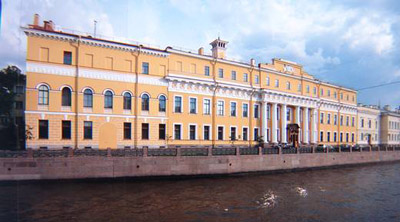
One of two surviving St. Petersburg residences of the monumentally wealthy Yusupov family, the Yusupov Palace on the Moika River is one of the few aristocratic homes in the city to have retained many of its original interiors.
http://www.yusupov-palace.ru/ru
St Isaac’s Cathedral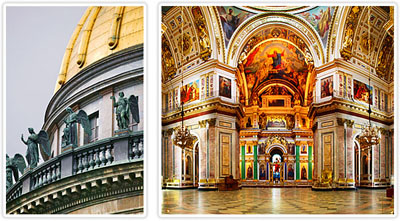
Designed by the architect Auguste Montferrand, St Isaac’s Cathedral is an outstanding monument of mid-19th century late Russian Neo-Classicism. Noteworthy is the Cathedral’s interior decoration, representing all forms of monumental and decorative arts – painting, sculpture, mosaic and colored stonework. Its main iconostasis is adorned with columns of malachite and lapis lazuli, while the main altar features the stained glass Christ Risen, a feature rarely seen in an Orthodox church.
http://eng.cathedral.ru/isakievskii_sobor
Savior on the Spilled Blood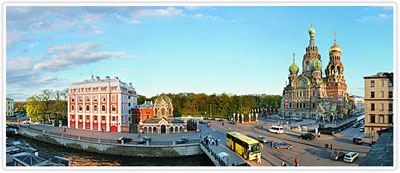
Savior on the Spilled Blood is an architectural landmark of central St Petersburg, and a unique monument to Alexander II the Liberator.
It features Russia’s largest collection of mosaics (over 7,000 sq.m.), Italian coloured marbles, decorative stones from the Urals and Altai region, as well as a collection of Russian heraldic mosaics.
http://eng.cathedral.ru/spasa_na_krovi
The Russian Museum 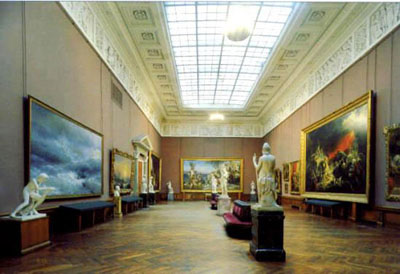
The Russian Museum is the first state museum of Russian fine arts in the country. It was established in 1895 in St Petersburg by a decree of the Emperor Nicholas II. Its grand opening for visitors occurred on March 19 (March 7, the Old Style) 1898.
The Russian Museum today is a unique depository of artistic treasures, a famous restoration centre, an authoritative institute of academic research, one of the major cultural and educational centers in Russia, and a research and instructional centre of art museums of the Russian Federation, overseeing activities of 260 art museums in Russia.
http://www.rusmuseum.ru/eng/home/
Peter and Paul Fortress
Paul Fortress is a unique example of Russian fortification construction from the early eighteenth century. The history of the fortress is connected with the struggle of Russian people for the outlet to the Baltic Sea. 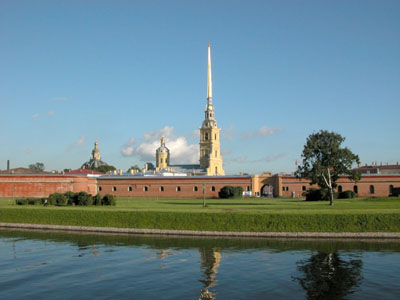
There is a number of historical buildings on the territory of the fortress. Among them are the Engineers’ House and the Commandant’s House – former residence of the fortress’s commandant. Both buildings, raised in the 1740s, are unique examples of the early Baroque style in Russia. The Peter and Paul Fortress houses the Mint (1805), which is the oldest enterprise in St. Petersburg, still producing coins, medals and badges. The Boathouse was designed in the late nineteenth century to accommodate Peter the Great’s boat, which he used to sail as a young man.
One of the main attractions in the fortress is Peter and Paul Cathedral, built in 1712 – 1733 as the main city cathedral. Designed in Baroque style by Domenico Trezzini, it combines typical features of West-European church architecture. Its 402 feet high belfry makes the cathedral the highest architectural structure in the city.
Peter and Paul Cathedral is the symbolic center of Russia because for two hundred years all Russian rulers from Peter I to Nicolas II (except Peter II and Ivan VI) and their families were buried here. Grand Ducal Burial Chapel was designed by David Grimm, Anton Tomishko and Leon Benois as the mausoleum for the Grand Dukes and Duchesses of Russia in 1908.
http://www.spbmuseum.ru/en/themuseum/museum_complex/peterpaul_fortress/
The Peterhof Museum Complex 
The Peterhof Museum Complex is one of the most popular museums not only in Russia, but in the whole world. Peter the Great planned Peterhof as the residence of a sea king.
Dotted with sparkling fountains, the Lower Park and Upper Gardens flow effortlessly into the shady and romantic glades of Alexandria, forming a unique fusion of regular and landscape parks. Every day, more than twenty museums — vastly different in their origins, ideas and contents — delight visitors with exciting new discoveries and the joy of their handsome treasures.
The Peterhof Museum Complex is rightfully regarded as the "capital of fountains." Included in the state register of most valuable cultural objects of the Russian Federation, Peterhof now bears the proud title of one of the "Seven Wonders of Russia."
http://peterhofmuseum.ru/?lang=eng
Tsarskoye Selo
The Tsarskoye Selo palace and park ensemble is a superb monument of world-ranking architecture and garden-and-park design dating from the eighteenth to early twentieth centuries. Tsarskoye Selo is a cluster of very fine examples of  Baroque and Classical architecture and it was also the first place in the Russian capital where interiors decorated in the Moderne (Art Nouveau) style appeared.
Baroque and Classical architecture and it was also the first place in the Russian capital where interiors decorated in the Moderne (Art Nouveau) style appeared.
The compositional centre of the ensemble is the Great Tsarskoye Selo or Catherine Palace – a splendid example of the Russian Baroque. Visitors are enraptured by the sumptuous décor of the Great Hall and the Golden Enfilade of staterooms that includes the world-famous Amber Room now returned to life. Today, as we enter the palace, we can sense the spirit of the times of Empresses Elizabeth and Catherine II and admire unique works of fine and applied art.
Tsarskoye Selo is also home to one of the finest creations of Classicism in architecture – the Alexander Palace. Passing through the rooms of the living apartments that are open to visitors, you can get an idea of the aesthetic preferences of the last members of the Romanov dynasty and view the Emperor’s State Study that was decorated in the Moderne style.
More than a hundred historical monuments are scattered across the Catherine and Alexander Parks that have a joint area of 300 hectares: there are grand palaces and intimate pavilions, bridges and marble monuments, and also exotic structures imitating Gothic, Turkish and Chinese architecture that invest little corners of the parks with a romantic atmosphere.
http://eng.tzar.ru/
Gatchina
The Gatchina Palace and park is one of Russia’s outstanding ensembles. With its own unique identity, it is just another gem in the ring of imperial suburban palaces around St Petersburg.
The palace and park at Gatchina dates back to the time of Empress Catherine II. In 1765, the tsarina gave her favourite, Count Grigory Orlov, a lavish gift – the Gatchina estate. The picturesque landscape, spring-fed lakes with connecting tributaries and rivers made it possible to create here the unique landscape park with the palace of remarkable architecture as its focal point.
http://gatchinapalace.ru/en/


